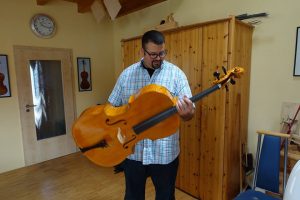I love new instruments. For as long as I’ve played the cello, I have always been drawn to new construction. The great antiques of the past are glorious, priceless treasures and they certainly hold their own mystique, but my heart has always beat a little faster for newly built instruments. Whenever the subject of new instruments is raised, one consistent comment/complaint always rears its troublesome head – the dreaded topic of “break in”. Do new instruments need to be broken in? Does the sound of a new instrument change as it is played? Is this something that should be considered a “defect” of a new instrument?
Everyone I know agrees that the sound of a brand-new, unplayed violin-family instrument will change as it is played. There is disagreement about how much of the change should be attributed to the instrument “settling” under the new pressure of the strings, brand-new strings seasoning with play, or the wood of the instrument “learning the notes” of new vibrations. Another seldom-discussed aspect of the break-in period is the player. As the musician learns the ideal use of the bow and left hand to coax the ideal sound from a particular instrument, he/she will coax that ideal sound more consistently generating the perception that the instrument is sounding “better and better”.
Encore focuses almost exclusively on offering recently constructed instruments to our customers. Because of this, I have had the privilege of watching thousands of instruments go through this “break-in” period. While not scientific, what I am going to present to you is a distillation of my experiences.
If you find yourself in possession of an instrument which has never been played before (as I currently find myself!), there are a few things I suggest:
- Strive to keep it perfectly in tune. We could have an entire discussion about the various merits of different frequencies of “A” employed over the years, but since there is a general, modern consensus for A = 440hz, I suggest tuning the strings accordingly. If the instrument does indeed “learn” notes, I like for it to remember the open strings perfectly in tune. If you have a smart phone, I highly recommend iStrobosoft from Peterson tuners. You can download an “orchestral” temperament package that will allow you to tune each open string perfectly and end up with beautiful fifths…something an electronic tuner based on equal temperament will not achieve.
- Play many slow scales (4-octave), working to draw maximum resonance on each note. These will “activate” all the ranges of the instrument.
- I also like to do slow glissandos up and down each string using the same reasoning as item #2.
- “hard” intervals like tri tones (D against G#) and minor seconds (F# against G), when played together, really get the entire instrument shaking! On a cello, I like to play the open G-string against F# on the C-string. Playing this as resonantly as possible will set the entire instrument vibrating. It can be a fairly awful sound, so don’t subject those around you to it for more than 60 seconds at a time! Doing this 5-10 times throughout the day for 60 seconds at a time seems to help the instrument “open up”.
- Playing long tones close to the bridge is similar to #4 in the way it helps the instrument. Don’t be afraid to get a “crunchy” sound close to the bridge when using this method.
- Finally, play something as beautifully as you can! If we want instruments capable of singing, we must make them sing. Some of what I suggested above will be awful sounding, so I feel strongly that we must make the instrument sound beautiful as well.
I’m not going to discuss break-in devices in this post because people have nearly religious feelings about them. I have used the readily available devices before and am convinced that they do indeed “do something”…I’m just not fully convinced that what they do is in the long-term best interest of a high-performance instrument. If you have specific questions about them, don’t hesitate to contact me!


Thanks for the tips! Really helpful.